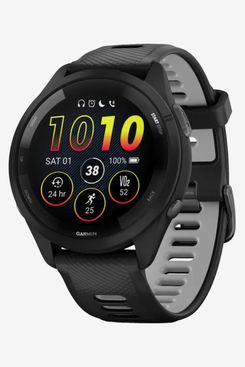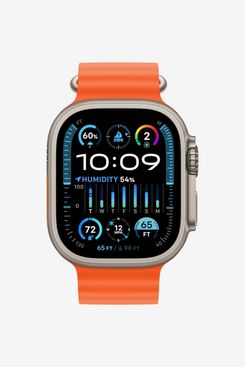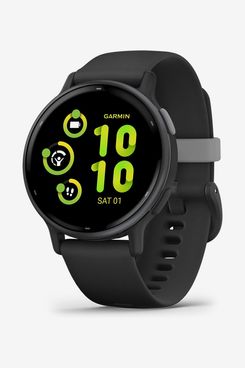
In this article
When I’m not running, I’m admittedly somewhat of a Luddite when it comes to wearable tech. I don’t like tracking every single activity. I still use wired headphones, the only non-sport watches I wear have an analog display, and I’ve only recently started wearing a smartwatch for non-athletic purposes. But when it comes to running, I want all the data. I track all of my runs with a running watch because it can provide important metrics, not only during my run but immediately after my sessions too — it’s like a mini-coach that fits on my wrist. I can compare that training data over time and chart my progress.
You might see running watches referred to interchangeably as smartwatches, fitness trackers, or GPS watches. Indeed, many of the watches below could be placed in any of those categories. But a running watch can generally be defined by the metrics it tracks: GPS capability, time, duration, distance, pace, and heart rate.
All of these watches will track and record those metrics (and load more activities, like biking, swimming, yoga, and gym workouts, for example), but there are a few differences that make each of these recommendations the right fit for certain runners. All I really care about as an intermediate runner is being able to track my runs, see my pace and heart rate, and then check out a map of my route when I get home. But for athletes like ultramarathoner Emily Halnon, a watch with more battery life will better suit her long-haul sessions. (She told us back in 2021 that she wears a Coros watch because of its “ridiculous” battery life.) Someone like pro surfer Nathan Florence, who runs and does other aerobic activities for cross-training, might find a multisport watch more beneficial than a simpler model that can only track a handful of basic activities.
To make it easier for you to choose the right running watch, I tested five models, running over 1,800 miles with them in the last year; spoke with running experts and professional athletes to find out which models they recommended; and rounded up all of the best watches we’ve written about before. Plus, I chatted with a few Strategist staffers and included their top picks.
Update on September 10, 2024: Updated prices and checked stock for all products.
Best running watch overall
The Forerunner 265 is my top recommendation because almost every feature is designed specifically with runners in mind, from its bright, easy-to-read screen, to its simple menu navigation, to the way it displays your metrics. I run some variation of the same loop on most of my training runs, so I have a good sense of where the mile markers are and what paces I normally hit at certain sections of the run. I found the Forerunner to be consistent and accurate with its GPS tracking (especially after cross-referencing with an online map pedometer), and the stats for my pace and heart rate were easy to read at a glance mid-stride. Its pace reading seemed accurate and quick — other watches have a tendency to lag and display a much slower pace than what I’m actually running (especially when I stop and then start again, like at a crosswalk). But my favorite feature is its AMOLED screen. It’s bright and colorful and easy to read in the sunlight, yet it’s also easy on the eyes at night.
Strategist newsletter editor Ashley Wolfgang swears by her Forerunner, which she’s been using for the past four years. “I was first introduced to Garmin after spotting a version of the watch on the wrists of nearly every runner in my running club,” she says. “I was particularly drawn to a (now discontinued) black and rose-gold colorway of the 645 that my friend has and bought the same one during a Black Friday sale in 2019. After previously running — and recording — all my runs with my phone in hand with the Strava app open, I loved how freeing wearing a running watch was.” It’s also one of Citius Mag founder Chris Chavez’s favorite watches.
Best (less expensive) overall
Much like the Forerunner, the Coros Pace series is well beloved among runners and a solid choice for folks who want a smartwatch but don’t need to track many other activities outside of running. The Pace has kept its design consistent throughout each iteration — like previous versions of the Pace, which I’ve tested, the Pace 3 has a customizable watch face and simple format. Its dial-button lets you scroll and navigate the screen — similar to the Apple Watch’s dial — and it has one other button below it. It’s also one of the most affordable running watches available.
My favorite aspect of the Pace is the Coros app, which I found to be the most straightforward and helpful dashboard for running training among those I tried. Oftentimes, these fitness apps are a headache to navigate (I don’t need a news feed or to read a company blog — I really just want to see my run data). The Coros app is refreshingly easy to use, and there aren’t any confusing pages or unnecessary metrics. I often wish I could use it with other running watches. Largely because of the app, I would recommend the Pace 3 — or the Apex Pro 2, below — to any runner who likes to dig into their data post-run.
Runner and former professional soccer player Hellah Sidibe, who ran across the country in 2021 and has run every day since 2017, often runs with two watches on each arm, as part of an ongoing test (he’s unsponsored).
When it comes to battery life, Sidibe says the Pace 3 is leagues better than the competition. “It’s one of those watches where I don’t worry about leaving my charger behind because I know it can give me a good amount of days,” he says. “I’m a person who runs every day, so I use it every single day. I can guarantee myself two weeks with no red battery warning coming on, nothing. I could probably go for three weeks — I just haven’t let it go that long.” It charges quickly, too. Sidibe says you can get a quick 10 to 15 percent boost within five minutes of charging.
Best for safety features
The Apple Watch is about as ubiquitous as the iPhone, and its features are well known. But after testing out different watch-screen interfaces for this article, I found that the Apple Watch’s felt familiar and intuitive — and I assume that’s true for other iPhone users or those who have devices in the Apple ecosystem. As someone who never runs with their phone, I find that the Apple Watch Ultra 2 is about as close as you can get to that experience without actually having to lug one around.
Unlike the Apple Watch Series 9, the Ultra 2 has an “Action Button” on the side that works like a shortcut start button for workouts, which I found handy on the days where I’d roll out of bed and want to get started on a run right away (as opposed to having to sit around and wait for the GPS to connect, like I do with some watches). As a Spotify user, I found it super-easy to load my playlists and listen to music while running. One thing you might want to consider is bulk: At 2.15 ounces, it’s the heaviest watch on this list (for comparison, the Forerunner 265 weighs 1.65 ounces). But once I get moving, that weight isn’t very noticeable.
Sidibe, who has tested 15 running watches in the last five years, says, “If I were to pick only one watch that I’d use for the rest of my life, I’m going to have to say the Apple Ultra 2, not only because it does a really good job tracking my miles and my pace, but because of its safety features. If I fall off a trail or anything like that, it can tell if it’s a really dangerous fall versus if I just jumped over something. If I’m unconscious, the watch can call the nearest emergency crew.”
In his guide to the best smartwatches, Strategist writer Jordan McMahon wrote that he thinks the Apple Watch Ultra 2’s “bigger screen, longer battery life, more durable design, and additional Action Button for quickly triggering workouts” are worthy of considering an upgrade. But if you don’t think you’ll need the bigger display and extra features and still want to stay in the Apple ecosystem, you might be better off sticking with the Apple Watch Series 9. (McMahon spoke with Thomas Watson, ultrarunner and editor-in-chief of Marathon Handbook, and Watson recommends the Series 9 because “it tracks just about every type of workout you can imagine.”)
Best for battery life
Coros has a reputation for making durable watches with incredible battery life, and the Apex Pro 2 is no exception. The brand lists the Apex Pro 2 as having an estimated battery life of 24 days with daily use. After consulting with friends who have used the Apex, I believe that to be accurate. Though I haven’t had the chance to test out the Apex Pro 2 specifically, I tested the Apex and the Apex 2, and there were weeks that went by where I’d only have to charge it once or twice — and even then, I didn’t have to charge the full battery. (The Pro 2 has a larger screen and a longer battery life compared to the Apex and Apex 2.) When Sidibe ran Western States, a 100-mile trail race in California, he wore four watches — and all of their batteries died during the race except for those of the Apex Pro 2. “It had 39 percent battery left, and I was using it for almost two weeks afterward,” he says.
That long-lasting battery is housed in a surprisingly small and lightweight case. When I spoke with professional runner Des Linden about her favorite gear, she described her Apex Pro 2 as an “insanely light” way to help her track workout data.
Best value
The majority of running watches can track the same things (pace, heart rate, etc.) and most but not all of the time, the differences between all that tracking are small (and even then, they might only matter to elite athletes). That’s why I found the Suunto Race, the brand’s premium running watch, to be such a good deal: It offers the wide selection of features that you’d find in a GPS multisport watch, like the Garmin Fenix 7 below, but at the same price as less expensive models like the Forerunner and Apex Pro 2.
The Race offers 95 (!) sport modes, a digital crown that helps you navigate through the menus and zoom in and out of maps, and a bright AMOLED screen that’s supremely readable, especially in the sun. In the few weeks I’ve tested the Race, the only complaint I have is that swiping and scrolling through the menu is slow. There’s a slight delay in the button input and what it triggers on the screen. If you’re trying to cycle through different modes and features by pressing buttons in succession, it can feel slightly laggy. But other than that, the Race felt easy to use.
Suunto watches in general will be a good investment in the long run. They got the stamp of approval from artist Geoff McFetridge, who’s also an avid runner, skier, and biker. He likes his Suunto because the brand supports older models with software updates — that means older models aren’t immediately obsolete when newer versions are released (an all-too-familiar tale).
Best for multisport athletes
If you’re a triathlete or a runner who also wants to track outdoor activities (or any sport), then the Fenix 7 Pro will be your best bet. It’s a premium GPS watch that has mapping capabilities, over two dozen different sports modes, a solar-charging lens that juices up the battery when you’re out in the sun, and a flashlight, which no other model on this list has. It’s a watch loaded with features that a trail runner would love, but to put it another way: This is the watch I’d want if I was lost in the woods or anywhere out in the wilderness.
While Garmin’s Fenix line is intended for serious outdoor athletes, I found its interface approachable and easy to use. There are four buttons and a responsive touch screen that doesn’t lag when navigating the menus. And while its features might feel like overkill — especially at $800 — it can track any activity imaginable.
Professional surfer Nathan Florence takes advantage of all those tracking capabilities. “I’ve been loving the Garmin for tracking surf sessions, workouts, cycling, everything,” he says. And he appreciates the insights it gives him into what his body is doing. “If I’m surfing 30-foot waves at Jaws, I want to see what my heart rate is doing out there,” he says. “It goes from resting heart rate to 185 for 30 seconds and then back down. That’s a wave, and a fall, and a beatdown. It’s just so cool to see.”
Best (less expensive) for multisport athletes
If you prefer a simpler watch that can log your run and help you organize fitness goals, then I would recommend the Vivoactive 5. What struck me immediately about it right out of the box was how discreet it is. Its case is smooth and simple, and besides two low-profile buttons on the right side of the watch, the rest of the face is featureless. Often the trade-off with more pared-down watches is you lose out on features like GPS and data tracking. Not the Vivoactive 5 — it offers sports modes for running, swimming, cycling, strength training, plus 26 other modes, in addition to the ability to load and store music. What I found most impressive about the Vivoactive was its display, which was brilliant and clear (similar to the Forerunner 265) and was readable during my run.
Overall, I would recommend the Vivoactive 5 to runners who prioritize other workouts and activities (and want to track them). We’ve written about a previous version of the Vivoactive — the 4s — which former Strategist senior writer (and avid runner) Karen Iorio Adelson said was “the best combination GPS watch and fitness tracker I’ve ever tried — and I’ve tried a lot.” For her, it replaced the Fitbit and her Garmin Forerunner as her regular tracker.
The Strategist is designed to surface the most useful, expert recommendations for things to buy across the vast e-commerce landscape. Some of our latest conquests include the best acne treatments, rolling luggage, pillows for side sleepers, natural anxiety remedies, and bath towels. We update links when possible, but note that deals can expire and all prices are subject to change.














